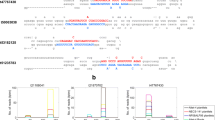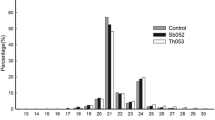Abstract
Glyphosate is a broad spectrum herbicide which has been widely used for non-selective weed control in turfgrass management. Festuca arundinacea cv. Falcon was shown to be one of the tolerant turfgrass species in response to varying levels of glyphosate [5% (1.58 mM), 20% (6.32 mM)] recommended for weed control. However, there is a lack of knowledge on the mRNA expression patterns and miRNA, critical regulators of gene expression, in response to varying levels of glyphosate treatments. Here, we investigate the transcriptome and miRNA-guided post-transcriptional networks using plant miRNA microarray and Affymetrix GeneChip® Wheat Genome Array platforms. Transcriptome analysis revealed 93 up-regulated and 78 down-regulated genes, whereas a smaller number showed inverse differential expressions. miRNA chip analysis indicated a number of (34 out of the 853) plant miRNAs were differentially regulated in response to glyphosate treatments. Target transcripts of differentially regulated miRNAs were predicted and nine of them were quantified by quantitative real-time PCR (qRT-PCR). Target transcripts of miRNAs validate the expression level change of miRNAs detected by miRNA microarray analysis. Down-regulation of miRNAs upon 5 and 20% glyphosate applications led to the up-regulation of their target observed by qRT-PCR or vice versa. Quantification of F. arundinacea miRNA, homologous of osa-miR1436, revealed the agreement between the Affymetrix and miRNA microarray analyses. In addition to miRNA microarray experiment, 25 conserved F. arundinacea miRNAs were identified through homology-based approach and their secondary structures were predicted. The results presented serve as analyses of genome-wide expression profiling of miRNAs and target mRNAs in response to foliar glyphosate treatment in grass species.






Similar content being viewed by others
Abbreviations
- ΔG :
-
Folding free energies
- cDNA:
-
Complementary DNA
- DE:
-
Differential expression
- EPSPS:
-
5-Enolpyruvylshikimate-3-phosphate synthase
- EST:
-
Expressed sequence tag
- Far:
-
Festuca arundinacea
- ISH:
-
Interspecies hybridization
- MFE:
-
Minimal folding free energy
- miRNA:
-
Micro-RNA
- NAC5:
-
NAC domain protein
- ndhF:
-
NADH dehydrogenase subunit F
- NCBI:
-
National Center of Biotechnology Information
- nt:
-
Nucleotide(s)
- PEP:
-
Glyphosate competes with phosphoenolpyruvate
- Pre-miRNA:
-
Micro-RNA precursor
- Pri-miRNAs:
-
Primary micro-RNAs
- PCA:
-
Principal component analysis
- qRT-PCR:
-
Quantitative real-time PCR
- RMA:
-
Robust multichip average
- RT:
-
Real time
- RuBP:
-
Ribulose bisphosphate
- Ser:
-
Serine
- Thr:
-
Threonine
References
Altschul SF, Madden TL, Schaffer AA, Zhang JH, Zhang Z, Miller W, Lipman DJ (1997) Gapped BLAST and PSIBLAST: a new generation of protein database search programs. Nucl Acids Res 25:3389–3402. doi:10.1093/nar/25.17.3389
Antony C, Cibert C, Géraud G, Santa Maria A, Maro B, Mayau V, Goud B (1992) The small GTP-binding protein rab6p is distributed from medial Golgi to the trans-Golgi network as determined by a confocal microscopic approach. J Cell Sci 103:785–796
Bartel DP (2004) MicroRNAs: genomics, biogenesis, mechanism, and function, Cell 116:281–197. doi:10.1016/S0092-8674(04)00045-5
Bartel B, Bartel DP (2003) MicroRNAs: at the root of plant development? Plant Physiol 132:709–717. doi:10.1104/pp.103.023630
Baylis AD (2000) Why glyphosate is a global herbicide: strengths, weaknesses and prospects. Pest Manag Sci 56:299–308. doi:10.1002/(SICI)1526-4998(200004)56:4<299:AID-PS144>3.3.CO;2-B
Bonnet E, Wuyts J, Rouze P, Van de Peer Y (2004) Detection of 91 potential conserved plant microRNAs in Arabidopsis thaliana and Oryza sativa identifies important target genes. Proc Natl Acad Sci USA 101:11511–11516. doi:10.1073/pnas.0404025101
Budak H, Shearman RC, Parmaksiz I, Dweikat I (2004a) Comparative analysis of seeded and vegetative biotype buffalograsses based on phylogenetic relationship using ISSRs, SSRs, RAPDs, and SRAPs. Theor Appl Genet 109:280–288. doi:10.1007/s00122-004-1630-z
Budak H, Shearman RC, Parmaksiz I, Gaussoin RE, Riordan TP, Dweikat I (2004b) Molecular characterization of Buffalograss germplasm using sequence-related amplified polymorphism markers. Theor Appl Genet 108:328–334. doi:10.1007/s00122-003-1428-4
Budak H, Shearman RC, Gulsen O, Dweikat I (2005) Understanding ploidy complex and geographic origin of Buchloe dactyloides genome using cytoplasmic and nuclear marker systems. Theor Appl Genet 111:1545–1552. doi:10.1007/s00122-005-0083-3
Budak H, Kasap Z, Shearman RC, Dweikat I, Sezerman U, Mahmood A (2006a) Molecular characterization of cDNA encoding resistance gene-like sequences in Buchloe dactyolides. Mol Biotechnol 34:293–301. doi:10.1385/MB:34:3:293
Budak H, Su S, Ergen N (2006b) Revealing constitutively expressed resistance genes in Agrostis species using PCR-based motif directed RNA fingerprinting. Genet Res 88:165–175. doi:10.1017/S0016672307008518
Cebeci O, Budak H (2009) Global expression patterns of three Festuca species exposed to different doses of glyphosate using the Affymetrix GeneChip Wheat Genome Array. Comp Funct Genomics 2009:1–10. doi:10.1155/2009/505701
Cebeci O, Kokturk B, Ergen N, Ozturk L, Cakmak I, Budak H (2008) Differential expression of wheat transcriptomes in response to varying cadmium concentrations. Biol Plant 52:703–708. doi:10.1007/s10535-008-0135-z
Devoto A, Muskett PR, Shirasu K (2003) Role of ubiquitination in the regulation of plant defense against pathogens. Curr Opin Plant Biol 6:307–311. doi:10.1016/S1369-5266(03)00060-8
Dinler G, Budak H (2008) Analysis of expressed sequence tags (ESTs) from Agrostis species obtained using sequence related amplified polymorphism. Biochem Genet 46:663–676. doi:10.1007/s10528-008-9181-7
Eisen MB, Spellman PT, Brown PO, Botstein D (1998) Cluster analysis and display of genome-wide expression patterns. Proc Natl Acad Sci USA 95:14863–14868. doi:10.1073/pnas.95.25.14863
Ergen NZ, Budak H (2009) Sequencing over 13 000 expressed sequence tags from six subtractive cDNA libraries of wild and modern wheats following slow drought stress. Plant Cell Environ 32:220–236. doi:10.1111/j.1365-3040.2008.01915.x
Ergen ZN, Dinler G, Shearman R, Budak H (2007) Identifying, cloning and structural analysis of differentially expressed genes upon Puccinia infection of Festuca rubra var. rubra. Gene 393:145–152. doi:10.1016/j.gene.2007.02.005
Ergen NZ, Thimmapuram J, Bohnert HJ, Budak H (2009) Transcriptome pathways unique to dehydration tolerant relatives of modern wheat. Funct Integr Genomics 9:377–396. doi:10.1007/s10142-009-0123-1
Ganesan G, Sankararamasubramanian HM, Narayanan JM, Sivaprakash KR, Parida A (2008) Transcript level characterization of a cDNA encoding stress regulated NAC transcription factor in the mangrove plant Avicennia marina. Plant Physiol Biochem 46:928–934. doi:10.1016/j.plaphy.2008.05.002
Geiger DR, Kapitan SW, Tucci MA (1986) Glyphosate inhibits photosynthesis and allocation of carbon to starch in sugar beet leaves. Plant Physiol 82:468–472. doi:10.1104/pp.82.2.468
Goud B, Zahraoui A, Tavitian A, Saraste J (1990) Small GTP-binding protein associated with Golgi cisternae. Nature 7:553–556. doi:10.1038/345553a0
Haizel T, Thomas M, Franziska T, Ferenc N (1995) Characterization of membrane-bound small CTP-binding proteins from Nicotiana tabacum. Plant Physiol 108:59–67. doi:10.1104/pp.108.1.59
Hammond SM, Bernstein E, Beach D, Hannon GJ (2000) An RNA-directed nuclease mediates post-transcriptional gene silencing in Drosophila cells. Nature 404:293–296. doi:10.1038/35005107
Jones-Rhoades MW, Bartel DP (2004) Computational identification of plant micro-RNAs and their targets, including a stress-induced miRNA. Mol. Cell 14:787–799. doi:10.1016/j.molcel.2004.05.027
Jurca ME, Bottka S, Fehér A (2008) Characterization of a family of Arabidopsis receptor-like cytoplasmic kinases (RLCK class VI). Plant Cell Rep 4:739–748. doi:10.1007/s00299-007-0494-5
Kim HS, Delaney TP (2002) Arabidopsis SON1 is an F-box protein that regulates a novel induced defense response independent of both salicylic acid and systemic acquired resistance. Plant Cell 14:1469–1482. doi:10.1105/tpc.001867
Kim KY, Park SW, Chung YS, Chung CH, Kim JI, Lee JH (2004) Molecular cloning of low-temperature-inducible ribosomal proteins from soybean. J Exp Bot 55:1153–1155. doi:10.1093/jxb/erh125
Kitchen LM, Witt WW, Rieck CE (1981) Inhibition of delta-aminolevulinic acid synthesis by glyphosate. Weed Sci 29:571–577
Llave C, Xie Z, Kasschau KD, Carrington JC (2002) Cleavage of Scarecrow-like mRNA targets directed by a class of Arabidopsis miRNA. Science 297:2056. doi:10.1126/science.1076311
Mallory AC, Reinhart BJ, Jones-Rhoades MW, Tang G, Zamore PD, Barton MK, Bartel DP (2004) MicroRNA control of PHABULOSA in leaf development: importance of pairing to the microRNA 5′ region. EMBO J 23:3356–3364. doi:10.1038/sj.emboj.7600340
Mette MF, Aufsatz W, Kanno T, Daxinger L, Rovina P, Matzke M, Matzke AJ (2005) Analysis of double-stranded RNA and small RNAs involved in RNA-mediated transcriptional gene silencing. Methods Mol Biol 309:61–82
Palme K, Diefenthal T, Moore I (1993) The ypt gene family from maize and Arabidopsis: structural and functional analysis. J Exp Bot 44:183–195
Raman S, Greb T, Peaucelle A, Blein T, Laufs P, Theres K (2008) Interplay of miR164, CUP-SHAPED COTYLEDON genes and LATERAL SUPPRESSOR controls axillary meristem formation in Arabidopsis thaliana. Plant J. 55:65–76. doi:10.1111/j.1365-313X.2008.03483.x
Reichman JR, Watrud LS, Lee EH, Burdick CA, Bollman MA, Storm MJ, King GA, Mallory-Smith C (2006) Establishment of transgenic herbicide-resistant creeping bentgrass (Agrostis stolonifera L.) in nonagronomic habitats. Mol Ecol 15:4243–4255. doi:10.1111/j.1365-294X.2006.03072.x
Reinhart BJ, Weinstein EG, Rhoades MW, Bartel B, Bartel DP (2002) MicroRNAs in plants. Genes Dev 16:1616–1626. doi:10.1101/gad.1004402
Rodriguez-Concepcion M, Fores O, Martinez-Garcia JF, Gonzalez V, Philips MA, Ferrer A, Boronot A (2004) Distinct light mediated pathways regulated the biosynthesis and exchange of isoprenoid precursors during Arabidopsis seedling development. Plant Cell 16:144–156. doi:10.1105/tpc.016204
Sergiev IG, Alexieva VS, Ivanov SV, Moskova II, Karanov EN (2006) The phenylurea cytokinin 4PU-30 protects maize plants against glyphosate action. Pestic Biochem Physiol 85:139–146. doi:10.1016/j.pestbp.2006.01.001
Servaites JC, Tucci MA, Geiger DR (1987) Glyphosate effects on carbon assimilation, ribulose bisphosphate carboxylase activity, and metabolite levels in sugar beet leaves. Plant Physiol 85:370–374. doi:10.1104/pp.85.2.370
Su YS, Ozturk L, Cakmak I, Budak H (2009) Turfgrass species response exposed to increasing rates of glyphosate application. Eur J Agron 31:120–125. doi:10.1016/j.eja.2009.05.011
Unver T, Budak H (2009) Conserved microRNAs and their targets in model grass species Brachypodium distachyon. Planta 4:659–669. doi:10.1007/s00425-009-0974-7
Unver T, Bozkurt O, Akkaya MS (2008) Identification of differentially expressed transcripts from leaves of the boron tolerant plant Gypsophila perfoliata L. Plant Cell Rep 27:1411–1422. doi:10.1007/s00299-008-0560-7
Unver T, Namuth-Covert DM, Budak H (2009) Review of current methodological approaches for characterizing microRNAs in plants. Int J Plant Genomics 262463. doi:10.1155/2009/262463
Varkonyi-Gasic E, Wu R, Wood M, Walton EF, Hellens RP (2007) Protocol: a highly sensitive RT-PCR method for detection and quantification of microRNAs. Plant Methods 3:1–12. doi:10.1186/1746-4811-3-12
Zhang BH, Pan XP, Wang QL, Cobb GP, Anderson TA (2005) Identification and characterization of new plant microRNAs using EST analysis. Cell Res. 15:336–360. doi:10.1038/sj.cr.7290302
Zhang BH, Pan XP, Cannon CH, Cobb GP, Anderson TA (2006) Conservation and divergence of plant microRNA genes. Plant J. 46:243–259. doi:10.1111/j.1365-313X.2006.02697.x
Acknowledgments
This work was partially supported by EU-FP6 Marie Curie International Reintegration Grant, Turkish National Academy of Sciences (TUBA-GEBIP) and Nebraska Turfgrass Association. Authors wish to acknowledge O. Cebeci, K. Yucebilgili and M. Aydin for the help with the preparing samples and data analysis.
Author information
Authors and Affiliations
Corresponding author
Additional information
Communicated by R. Hagemann.
Electronic supplementary material
Below is the link to the electronic supplementary material.
Rights and permissions
About this article
Cite this article
Unver, T., Bakar, M., Shearman, R.C. et al. Genome-wide profiling and analysis of Festuca arundinacea miRNAs and transcriptomes in response to foliar glyphosate application. Mol Genet Genomics 283, 397–413 (2010). https://doi.org/10.1007/s00438-010-0526-7
Received:
Accepted:
Published:
Issue Date:
DOI: https://doi.org/10.1007/s00438-010-0526-7




